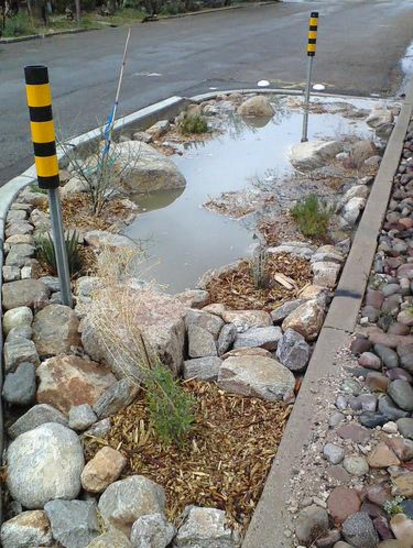Rain Gardens
Rain gardens are planted basins which have several key purposes including, increasing infiltration of run-off into the ground, improving water quality by removing pollutants from run-off and reducing the volume of stormwater runoff which ultimately enters the stormwater management system. Rain gardens appear similar to a “regular” garden, however, they are unique in shape. Rain gardens are typically bowl- or saucer-shaped and specifically designed to collect runoff and hold it for up to a day or two as the water infiltrates into the surrounding soil.
Rain gardens may be designed in styles ranging from natural to highly manicured, incorporating perennials, shrubs, wildflowers, and/or grasses. Rain gardens function year-round to provide short-term water storage and water filtration benefits.
Hazard Mitigation
Rain gardens reduce the volume of stormwater that enters the larger stormwater management system by increasing infilitration of run-off into the ground during rain events.
Siting Considerations
Rain gardens are often placed in an area that receives runoff from a roof or paved area (driveway, parking lot, patio, etc.). Appropriate sites for rain gardens must have adequate sunlight and be relatively flat (with a slope of no more than 15 percent).
In areas with poor drainage (such as those with clay soils), a gravel bed and underdrain should be incorporated into the design to prevent waterlogging. Rain gardens should not be placed in areas where water pools, but may be placed upslope of such an area to eliminate the pooling. Other areas to be avoided include locations near building foundations (to prevent structural damage) and areas with heavy foot traffic (which could compact soils).
Rain gardens are most effective on a small scale, receiving runoff from an area of no more than one to two acres (to avoid high volume flows that would erode plant materials), and are typically found at the site level. Because they are low-risk and do not require professional engineering, small rain gardens (less than 300 square feet) may be installed by homeowners as do-it-yourself projects. As a general rule of thumb, rain gardens should be between 10 and 20 percent of the square footage of the area of impervious surface (driveway, sidewalks, etc.) that they are receiving runoff from. However, any size rain garden can be beneficial.
Costs
The costs of installing a rain garden will vary based on size, soil condition, and design, but they are generally low ($3-$5 per square foot for residential installations, $10 per square foot or more for large commercial sites). Maintenance costs are minimal.

Co-Benefits of the Strategy
Rain gardens benefit the environment through the removal of pollutants from stormwater runoff as well as recharging groundwater supplies. Well-designed rain gardens can also improve the aesthetics of a property (and, as a result, improve property value) and provide a natural habitat for birds and pollinators. They are a popular project for schools and parks as an environmental education showpiece.
Maintenance Considerations
Maintenance requirements are minimal due to the use of hardy, native plant materials. Weeds and invasive plants must be removed along with any debris that may collect in the plant materials. Once the garden is established, watering is only necessary during drought conditions. Mulch should be added on an annual basis.
Underdrains (where installed) may become clogged, causing water to back up in the garden. If this occurs, any obstructions must be cleared.
Similar or Complementary Solutions
Rain gardens are often stand-alone stormwater management solutions, especially on single-family residential properties. However, especially when located on larger sites, they may receive runoff from a bioswale, green parking lot, or green roof. The overflow (and underdrain, if present) from a rain garden may be directed into a bioswale or other natural infrastructure solution.
Additional Information
Additional guidance on raingarden design and maintenance is available at these sites.
http://www.fairfaxcounty.gov/nvswcd/raingardenbk.pdf
http://water.tamu.edu/files/2013/02/stormwater-management-rain-gardens.pdf
http://indiana.clearchoicescleanwater.org/plants/rain-garden-faqs
http://www.lowimpactdevelopment.org/raingarden_design/whatisaraingarden.htm#PDFs






